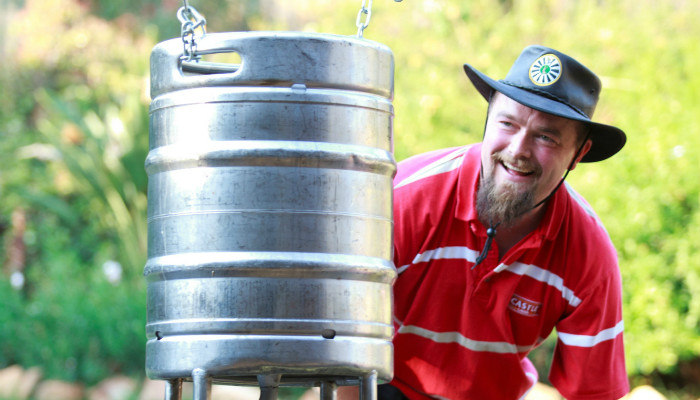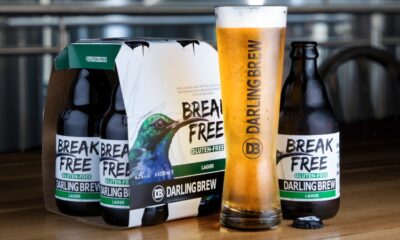Beverages
Here’s How To Make Your Own Beer, According To An Expert
SAB brewmaster at Chamdor (and avid home brewer), Danie Odendaal gives us some key tips on how to create your own golden nectar from the comfort of your home.

It goes without saying South Africans love their beer and that we have a great beer culture.
In fact, many “beer-philes” have turned this appreciation into a hobby and are fermenting their favoured pint from the comfort of their homes.
Being the country’s premier brewer, The South African Breweries (SAB) has over a century of brewing expertise and is only too happy to share some guidelines for those who wish to try their hand at home brewing.
Whilst we can’t promise that you will become a home-brewing whizz overnight, SAB’s brew master Danie Odendaal will inspire you with his uncompromising commitment to brewing excellence and help jumpstart your home brewing journey.
There are two easy ways of brewing – by using a brew kit or “brew in a bag”. Both methods use the same equipment and are a great way to start your new hobby of making beer.
Beer kit
The beer kit is the easiest way to try your hand at brewing because essentially another brewer does all the work and you start with a concentrated syrup of malt goodness. For first time brewers, I would recommend starting with the beer kit, which can be bought online or at reputable home brew shops.
It is a “paint by numbers” system that guides you through the “make your beer” process and importantly, ensures you work cleanly and in a sterile environment. If your beer is undrinkable, you have not worked cleanly enough and should possibly practice more before attempting a brew in a bag.
Tools for your brew
- 15 to 20 L pot;
- A thermometer – not the mercury type;
- White 25 L plastic fermenting bucket;
- This can be bought from a local brew shop and comes with a tap and a fermentation lock (also known as a bubbler).
- Alternatively an ordinary bucket can be bought from a plastic shop and you will need to make your own fermentation lock – click here to see how.
- TIP: This is a fermenter, ensure it is not used for anything else.
- Sterilising liquid – follow your local brew shop recommendation;
- Try to stay away from bleach.
- Brew bag – a material, mesh bag in which crushed grains will be placed;
- Again, this can be bought from a local brew shop or can be made.
- For home-made, visit a local fabric shop and chose a good quality, netted curtain that will fit the brewing pot easily.
- 2 x cases of glass beer bottles;
- Caps – to fit on top of your bottles;
- Capper – the device used to secure your caps onto your bottles; and
- 1.5 m clear plastic tubing for filling the bottles.
For the first 20 L brew, let’s make an all malt, easy, English pale ale. Once you are comfortable with the basic brewing steps, you can experiment with the different raw materials, hops etc. If you want to know more about different beer styles, visit www.BJCP.org.
Ingredients for your all malt, easy, English pale ale
Available from a local brew shop, you will need:
- 2.9 kg pale malt – if possible, get the brew shop to mill it for you as this will save you the “trouble” later.
- 250 grams crystal malt or similar – get this milled as well.
- Fermentis SO4 English ale yeast – this is a very good yeast that has never disappointed me and does not require a starter to be made, which simplifies your brewing day.
- 15 grams Type 90 hop pellets Southern Promise Hop variety – this hop is very affordable.
- If this hop is not available, ask the brew shop owner to suggest a replacement.
- 1 whirlfloc tablet – helps clarify your boiled wort (the sweet liquid of ground malt or other grain before fermentation).
Now let’s get started
Let’s start Mashing
- Add 12 L of tap water to your pot and heat up to 68°C. Check with your thermometer that you do not exceed 68°C and try to maintain this temperature throughout your brewing process.
- Line the pot with your brew bag and fold the top over the edges of the pot. If you are using gas, be careful not to set your bag alight!
- Take your milled malt and mix it into the water with a mixing spoon (a clean one from the kitchen will do). This is called mashing in your brew.
- Once all the malt is mashed into the pot, ensure the temperature is still at 68°C.
- Now allow the natural malt enzymes to do their job for 60 minutes while checking the temperature from time to time. Stir the mash whenever you adjust your temperature, otherwise give your mash a stir about every 8-10 minutes.
- With a teaspoon, taste your mash during this process and over the 60 minutes, you will notice how the sweetness increases.
- Taste a teaspoon of your mash during this process and you will notice how the sweetness increases over the 60 min period.
Let’s start lautering (a German brewing term for liquid solid separation)
- After the 60 minute process, gather your bag at the top and slowly raise it out the pot and allow the liquid to drain from the bag. This sweet liquid is the wort.
- Rinse the grains with 23 L of preheated water from a kettle (the temperature should be between 68°C and 78°C). Just let the water runover your grain and straight into your pot.
- It is important to note, this process takes your total water content to 14 L.
- Throw away the grains. If you have a compost heap, even better, toss them onto the heap.
Boiling the wort
- Place your pot of sweet wort to boil for 60 minutes. Be careful it does not over boil because once a rolling boil has been achieved, this can easily happen.
- Do not cover the pot – reason being is you want to improve the flavour of your beer by driving off volatiles during the boil process.
- After 40 minutes of boiling you can add 15 g of hops.
- It is best to switch off the heat before you do this because the addition can easily trigger an over boil.
- Boil for a further 20 minutes to extract your hop bitterness and aroma.
- 5 min before the end of 60 minute boil, add the whirl floc tablet.
- At the end of the boiling process, turn the heat off and stir the pot to create a whirlpool effect.
- Let the pot stand for 10 minutes.
Preparing your fermenter
Post the boiling process, you need to employ your best surgical theatre impersonation. This is where it can go all wrong and a microorganism (other than your brewing yeast) can spoil your hard work.
- Clean your fermenter with a soft brush and dish washing liquid/unscented liquid soap.
- Wash the inside first then the outside.
- Wash first then sterilise (you cannot sterilise dirt!)
- Don’t forget to wash the bucket lid.
- Do not scrub with a wired or rough sponge or brush because germs will grow in the scratched grooves.
- Now add your sterilising liquid, close the bucket and shake the bucket to ensure the sterilising liquid comes in contact with the whole bucket.
- TIP: I generally shake intermittently at the start of the boiling process to maximise the sanitising effect
- Crack the bucket lid open (do not remove) and drain the liquid. Take some partially cooled boiled water (500 ml to 1 L) and add to the bucket, close the lid and shake. Drain this rinsed water by cracking the lid once more. Most sterilising liquids have a negative effect on your beer flavour so rinsing well is crucial.
Filling your fermenter
Now that your fermenter is sanitised, how do you cool the hot wort that finished boiling 10 minutes ago? There are immersion (dunking) or counter-flow chillers you may want to invest in but for now try the following:
- Take a cooler-box big enough for the fermenter to stand in.
- This brew is a 20 L recipe of which we have 14 L already. Add another 7 LB of previously boiled water to your fermenter. Do not worry about the extra 1 L because you will lose between 800ml to 1 L during the boiling process.
- When you remove the lid to add the water, it is very important that your hands are clean. Also, do not place the lid with its clean side onto the table.
- Once you have added the water, put the lid back on and place into the cooler-box. Pack ice around the bucket until the cooler-box is full.
- The quicker you can get this done, the better because you need to cool your brew down as fast as possible once it is added.
- After the boiled pot has been standing for 10 minutes, add its contents to the waiting fermenter.
- The hop and denatured proteins form a light brown-greenish sediment called trub. When transferring the wort into your fermenter be careful not to transfer this trub sediment into your fermenter. Rather sacrifice some of the liquid in the kettle to ensure minimum trub gets into your fermenter. I normally brew 2 L more than I need to ensure I can leave this volume at the end thus ensuring maximum sediment retention at the end of my kettle to Fermenter transfer.,
- TIP: Cleanliness again, wash hands before removing the lid and tipping. Remember the clean side of the lid must not touch the table top.
- Replace the lid and ensure it is slightly cracked, to allow for any cooling contraction.
Pitching the yeast
- Sterilise your thermometer and then confirm the temperature is below 24°C before you can pitch your yeast.
- You can use a cheap bottle of vodka to help sanitise the yeast packet before opening it. Do the same with the scissors. (No, you cannot use your teeth to open the packet.)
- Crack the lid and gently sprinkle the yeast over the surface of the wort in the fermenter and securely close the lid again.
- TIP: Cleanliness again when handling the lid. A little bit of vodka on your hands cannot hurt and you can even put it in a spray bottle. If a drop or two makes its way into your brew, no harm will be done.
- Now that the yeast is pitched with the lid on tight, place the fermenter bucket somewhere cool and wait.
- After 24 hours, you should see the ferment airlock bubbling and by the seventh day, it should have stopped.
- If the bucket lid is not airtight, the ferment lock will not work.
Bottling your beer
Prepare for bottling
- After a week when there is no activity happening around the airlock, your beer is ready for bottling.
- Sterilise your bottles.
- 20 L of beer will need approximately 24 x 750ml beer bottles.
- Plastic beer bottles can also be used and are available from a local brew shop.
- To supply carbonation (the fizz) to your beer, you need to prime the bottle first.
- This is done with sugar or dried malt extract.
- For simplicity, let’s stick to sugar.
- You will need a (almost level/shake off) teaspoon per bottle to give sufficient fizz.
- A sterilised funnel should help the fizz too. Do not add too much sugar otherwise your bottles will burst.
- Sanitise your bottle caps in some vodka or sterilising liquid.
- All equipment must be sterilised before transferring the beer to the bottles (i.e. plastic tubing and tubing attachments).
- Attach your sanitised clear plastic tubing to your sanitised fermenter tap.
- Make sure your bottles are thoroughly cleaned before you use them. This is the worst part of the job but if not done properly, it can ruin all you hard work.
- Tip: Ask the brew shop about the various aides that can make the task easier.
- Fill your bottles one by one.
- Tip: Ask the brew shop about the “spring loaded bottle filler attachment”, which are inexpensive and work like a charm (but you can make do without one).
- Cap the bottle with a bottle capper.
- Repeat this step until all your bottles are capped.
Wait – you cannot drink your beer yet
You need to age your beer before you can drink it. The reason for this is that the sugar will ferment in a sealed bottle and produce an ever so slight increase in alcohol but most importantly, increase the carbon dioxide. This carbon dioxide will dissolve into the beer and give it some great natural carbonation. This process is called bottle conditioning.
- Store the bottles at room temperature for a minimum of a week, preferably two.
- Only then, can the bottles be refrigerated, ready for consumption.
- Now enjoy your beer.
The last tip: When you pour your beer, leave a tiny bit in the bottle because the sediment has a yeast taste. You have bottle conditioned your beer after all!
Remember, practice makes perfect.
Once you have brewed your own beer a couple of times, you will be more confident to experiment with different ingredients, recipes, flavours and aromas.
“Beer is proof God loves us and wants us to be happy” – Enjoy!














